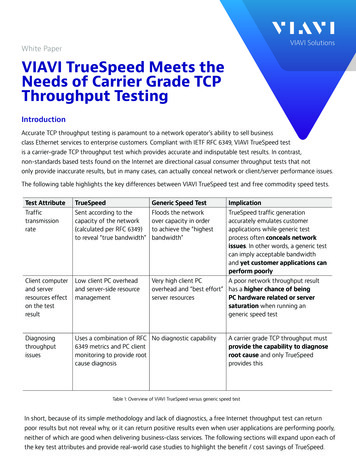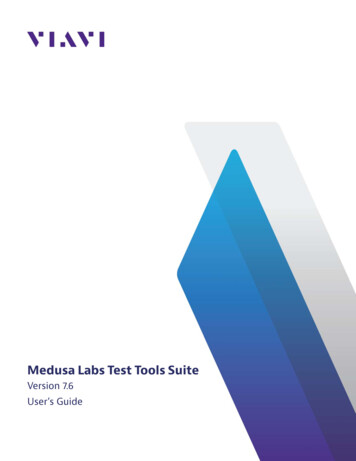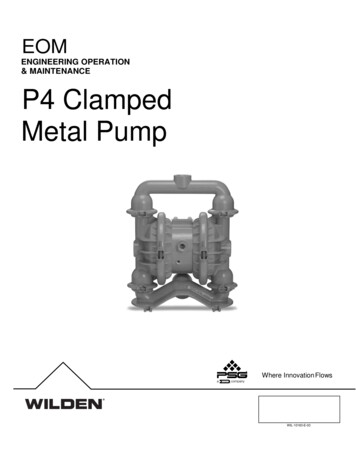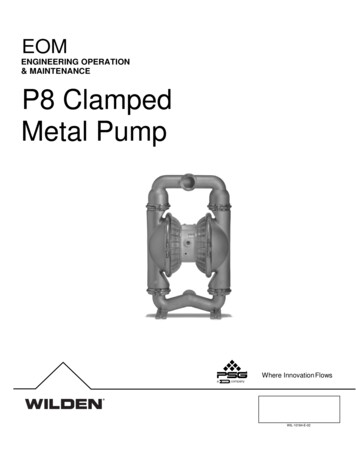
Transcription
VIAVI SolutionsWhite PaperVIAVI TrueSpeed Meets theNeeds of Carrier Grade TCPThroughput TestingIntroductionAccurate TCP throughput testing is paramount to a network operator’s ability to sell businessclass Ethernet services to enterprise customers. Compliant with IETF RFC 6349, VIAVI TrueSpeed testis a carrier-grade TCP throughput test which provides accurate and indisputable test results. In contrast,non-standards based tests found on the Internet are directional casual consumer throughput tests that notonly provide inaccurate results, but in many cases, can actually conceal network or client/server performance issues.The following table highlights the key differences between VIAVI TrueSpeed test and free commodity speed tests.Test AttributeTrueSpeedGeneric Speed TestImplicationTraffictransmissionrateSent according to thecapacity of the network(calculated per RFC 6349)to reveal “true bandwidth”Floods the networkover capacity in orderto achieve the “highestbandwidth”TrueSpeed traffic generationaccurately emulates customerapplications while generic testprocess often conceals networkissues. In other words, a generic testcan imply acceptable bandwidthand yet customer applications canperform poorlyClient computerand serverresources effecton the testresultLow client PC overheadand server-side resourcemanagementVery high client PCA poor network throughput resultoverhead and “best effort” has a higher chance of beingserver resourcesPC hardware related or serversaturation when running angeneric speed testDiagnosingthroughputissuesUses a combination of RFC No diagnostic capability6349 metrics and PC clientmonitoring to provide rootcause diagnosisA carrier grade TCP throughput mustprovide the capability to diagnoseroot cause and only TrueSpeedprovides thisTable 1: Overview of VIAVI TrueSpeed versus generic speed testIn short, because of its simple methodology and lack of diagnostics, a free Internet throughput test can returnpoor results but not reveal why, or it can return positive results even when user applications are performing poorly,neither of which are good when delivering business-class services. The following sections will expand upon each ofthe key test attributes and provide real-world case studies to highlight the benefit / cost savings of TrueSpeed.
Traffic Transmission RateA good TCP throughput test uses parallel TCP connections to achieve the full network bandwidth. Parallelconnections are more representative of how a consumer uses bandwidth; i.e. multiple video streams, webbrowsing sessions, Facebook, etc. occurring at the same time.The key question becomes, “how many connections and what window size should be used to achieve fullbandwidth?” According to RFC 6349, the Bandwidth Delay Product (BDP) is the product of a data link’s capacity(in bits per second) and its end-to-end delay (in seconds).Bandwidth Delay Product (BDP) BDP Round Trip Time (RTT) * Bandwidth / 8Using an example network bandwidth of GigE (1000Mbps) with 20 ms RTT),y BDP 20 ms * 1000 Mbps / 8 2.5 MBytesIn the simplest terms, the BDP can be thought of the number of bytes that a sender can send to achieve aspecified bandwidth.Commodity speed tests do not consider the network’s BDP and provides rudimentary configuration settingsto control the amount of data that is “shoved” into the pipe. In many cases this causes a generic test to oversubscribe a network resulting in excessive packet loss, BUT the oversubscription can provide high throughputnumbers and mask potential issues in queues, shapers, policers, etc.As a simple analogy, think of the BDP as a 25mm in diameter water hose and TCP traffic as water released intothe hose from a water faucet. Referencing Figure 1, assume that a bucket on the end of the hose is 5 liters and at awater faucet rate of 1 liter per minute, the bucket should be filled in 5 minutes.1 liter/minute TCP flowTCP Traffic Flow25mm diameter pipe1 liter/minute flow5 liter bucket5 minutefill timeFigure 1: Simple Illustration of TCP “Water” Flow2 VIAVI TrueSpeed Meets the Needs of Carrier Grade TCP Throughput Testing
If there are no holes or leaks in the hose, then simply turning the faucet on to 1 liter per minute (consider this the“BDP”) will fill the bucket in 5 minutes. But if there are holes in the hose, leaks will occur, and the bucket will takelonger to fill if the water flow remains fixed at 1 liter per minute (figure 2).1 liter/minute TCP flowTCP Traffic Flow25mm diameter pipe½ liter/minute leak½ liter/minute flow5 liter bucket10 minutefill timeFigure 2: “Network Problem” scenarioUsing a commodity speed test however, the test increases the water flow rate by some amount, let’s say 50% (1.5liters per minute), and the bucket still fills in 5 minutes (despite 50% of the water wasted and leaking (figure 3)).1.5 liter/minute TCP flowduring commodity speed test burstTCP Traffic Flow25mm diameter pipe½ liter/minute leak1 liter/minute flow“Normal” resultsdespite leakage5 liter bucket5 minutefill timeFigure 3: Generic speed test during network problemMeanwhile, a TrueSpeed test never tries to conceal leaks and only releases water at the 1 liter per minute rate.The bucket takes 10 minutes to fill!While this may seem like an overly simplistic example, it is remarkably similar to how a free Internet speed testmeasures network throughput (with a high rate of packet drops) versus TrueSpeed. In several case studies, anend customer reported a perfect throughput result with a commodity test and yet when doing an FTP (etc.), thethroughput is much lower. Meanwhile in the same case studies, TrueSpeed accurately detects the network issueand demonstrates throughput consistent with the end customer applications (FTP in this example).3 VIAVI TrueSpeed Meets the Needs of Carrier Grade TCP Throughput Testing
Getting into the technical details of the case study, let’s look at the TCP performance of a generic test versusTrueSpeed for this customer. Figures 3 and 4 show the results of a generic test and VIAVI TrueSpeed TCPthroughput test. Note that the test was conducted for a 100 Mbps business services customer.Figure 4: Generic Test Results for 100 Mbps Business ServiceFigure 5: VIAVI TrueSpeed Test Results for 100 Mbps Business ServiceThe generic test result achieved full TCP layer throughput ( 94 Mbps) even in the midst of severe TCPretransmissions (packet loss). Meanwhile, TrueSpeed correctly showed that the end customer would experienceonly 30 Mbps (!!) which was in line with the complaint filed by the customer (FTPs only achieving 30 Mbps).4 VIAVI TrueSpeed Meets the Needs of Carrier Grade TCP Throughput Testing
Client and Server Resource EffectsTo achieve an accurate TCP throughput test, client or server resource issues must not impact the results. Otherwise,compute resource issues may mislead one to believe that the network is the problem when it isn’t. Client processordemands for commodity throughput tests are very high compared to TrueSpeed’s, and may impact test results.To illustrate the CPU consumption difference, the ability of various performance laptops to achieve full Gigabit TCPthroughput was compared. Note that TCP maximum throughput under this condition is 949 Mbps. In all cases, thelaptops were Microsoft Windows 7 OS with all patches applied. No other applications were run on the laptops andthey were connected directly to the customer router.Client Laptop SpecificationCommodity Speed TestTCP ThroughputVIAVI TrueSpeedIntel Core i3, 1.3 GHz, 4GB, Laptop242 Mbps902 MbpsIntel Core Duo E8500 3.16 GHz, 4GB, Desktop339 Mbps942 MbpsIntel Core i5 2.5 GHz, 4GB, Laptop754 Mbps949 MbpsTable 2: Commodity speed test versus VIAVI TrueSpeed Performance on Different Client Hardware PlatformsBecause the free Internet speed test selected for the comparison is a Java application (standard among the freetests) while TrueSpeed is a “tuned thick client,” TrueSpeed outperformed the commodity test. Speedtest. This isobviously very important because when application performance dips, customers almost always assume it’s thenetwork and start opening trouble tickets. Without diagnostics, call center technicians are forced to prove it is nota network problem and dispatch a technician to investigate. However, as we see above, many times the problemis a limit of the hardware platform and not the network, which results in wasted technician time. TrueSpeedreduces truck-rolls by providing call center technicians CPU utilization charts as part of its extensive reportingcapability (more on this in the next section), letting technicians know quickly whether the problem is the networkor something else.Another difference between a commodity test and VIAVI TrueSpeed involves the server-side congestionmanagement. With the generic tests, if too many customer tests are run concurrently, the server does not limit thenumber of tests to the capacity of the server. This causes poor test performance (and reduced predictability) whichmay lead to incorrect conclusions.In contrast, the VIAVI TrueSpeed solution actively limits the number of concurrent tests based on the availabletest capacity of the server, which equates to the overall throughput and number of concurrent tests permittedto consume this throughput. Additionally, the network operator is also provided with detailed report charts ofserver CPU utilization during the test so that the network technician/engineer can determine if a server upgrade ismerited (there may be other applications running on the same server). Even when no test capacity is available, notest request is dropped since every outstanding TrueSpeed test is automatically placed into a queue to be executedonce resources become available again.5 VIAVI TrueSpeed Meets the Needs of Carrier Grade TCP Throughput Testing
Diagnosis of Throughput IssuesRunning a casual bandwidth test can only determine “what is my bandwidth”, but the important questionsremain unanswered:1. Why is my bandwidth lower than expected?2. How do I fix the issue?Proper diagnostic tools highlight many possible conditions that may degrade performance including:y Under powered laptop running the bandwidth testy Inadequate traffic shaper settings that cannot handle bursty TCP trafficy Laptop running the test overloaded with other applications such as virus scanning software, etc.Layer 4 (TCP) proxy devices such as stateful firewalls, virus scanners, intrusion detection systems (IDS)that are “in the middle” of a bandwidth test and can adversely affect performancey Duplex mismatchesy Inadvertent use of WiFi connection when testing a GigE serviceThe following are a representative examples which highlight key client and network conditions thatVIAVI TrueSpeed can diagnose while a commodity speed test pulled from the Internet cannot.In some cases, performance issues may involve the client host computer. Section 4.1 showed the significantclient-side resource requirements of a generic test versus TrueSpeed VNF, but what if the client laptop has enough“horsepower” but there are other applications consuming resources during the throughput test?The VIAVI solution reports client side CPU utilization AND provides a list of processes that were detected duringthe throughput test. Figure 6 shows an example of an overloaded client computer and the process which causedthe overload.Figure 6: High Client CPU Utilization and List of Possible Client Processes6 VIAVI TrueSpeed Meets the Needs of Carrier Grade TCP Throughput Testing
There are also times when a customer may inadvertently have used WiFi for the test instead of using the dedicatedwired interface. The VIAVI TrueSpeed report provides a list of network interface cards that were active during thetest, providing the network provider the ability to diagnose problems that would otherwise require a technician tobe dispatched to the customer premises. (Figure 8).In this example, the download CIR was 70 Mbps and the throughput achieved by the client PC was only 22 Mbps.Figure 7: Download Test ResultTrueSpeed provides the call center technician with the information to show that the client PC was using WiFiadapter instead of wired adapter which is a common mistake.Figure 8: TrueSpeed Report of Client Side NIC Settings7 VIAVI TrueSpeed Meets the Needs of Carrier Grade TCP Throughput Testing
In many cases, the proxy device is “in the middle” of the network segment to be tested and can have veryadverse effects on TCP throughput (firewall, virus scanner, Internet content filter, etc.). Unlike a casualthroughput test, VIAVI TrueSpeed detects many proxy conditions as part of its broader TCP diagnosticsreporting. When a network proxy is detected during a TrueSpeed VNF test, the backend server report wouldprovide the following diagnosis:“Warning: Inconsistent RTT values detected. This usually means a TCP proxy intercepted the connection and mighthave skewed the test results. There may be a Firewall, virus scanner, VPN concentrator, or other network appliancein the path whose processing imposes an additional constraint on the packet switching rate.”ConclusionsIn today’s digital world, everyone wants high-performance connectivity, and they want their network serviceprovider to give them what they’re paying for. Regarding the second of those, commodity throughput testsgive consumers a general indication of the throughput performance they’re receiving. However, for moredemanding business customers with revenue in the balance and SLAs that must be met, those generic testsare woefully inadequate.The generic tests deliver inconsistent results at best, and mask problems at worst. Due to faulty methodologyand poor diagnostics, a provider may determine from information from one of those generic tests thatthe network is OK when it isn’t, or that the network has a problem when it doesn’t. Neither of those falsediagnoses are good for the experience of valuable business customers or for operating efficiency.Built on industry standards, VIAVI TrueSpeed runs rigorous throughput tests that yield accurate, consistentresults and produce valuable diagnostic information, both customer and network-related, that help operatorsidentify and solve problems quickly.Contact Us 1 844 GO VIAVI( 1 844 468 4284)To reach the VIAVI office nearest you,visit viavisolutions.com/contact 2020 VIAVI Solutions Inc.Product specifications and descriptions in thisdocument are subject to change without notice.truespeed-wp-cab-nse-ae30187646 901 0620viavisolutions.com
Throughput Testing Introduction Accurate TCP throughput testing is paramount to a network operator's ability to sell business class Ethernet services to enterprise customers. Compliant with IETF RFC 6349, VIAVI TrueSpeed test is a carrier-grade TCP throughput test which provides accurate and indisputable test results. In contrast,










